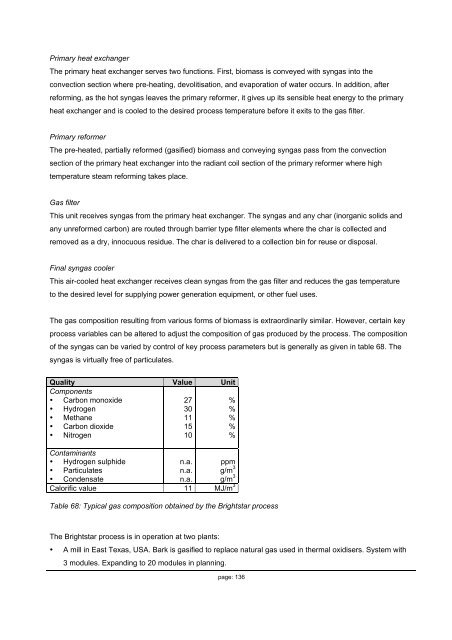Adding gas from biomass to the gas grid - SGC
Adding gas from biomass to the gas grid - SGC
Adding gas from biomass to the gas grid - SGC
- No tags were found...
Create successful ePaper yourself
Turn your PDF publications into a flip-book with our unique Google optimized e-Paper software.
Primary heat exchangerThe primary heat exchanger serves two functions. First, <strong>biomass</strong> is conveyed with syn<strong>gas</strong> in<strong>to</strong> <strong>the</strong>convection section where pre-heating, devolitisation, and evaporation of water occurs. In addition, afterreforming, as <strong>the</strong> hot syn<strong>gas</strong> leaves <strong>the</strong> primary reformer, it gives up its sensible heat energy <strong>to</strong> <strong>the</strong> primaryheat exchanger and is cooled <strong>to</strong> <strong>the</strong> desired process temperature before it exits <strong>to</strong> <strong>the</strong> <strong>gas</strong> filter.Primary reformerThe pre-heated, partially reformed (<strong>gas</strong>ified) <strong>biomass</strong> and conveying syn<strong>gas</strong> pass <strong>from</strong> <strong>the</strong> convectionsection of <strong>the</strong> primary heat exchanger in<strong>to</strong> <strong>the</strong> radiant coil section of <strong>the</strong> primary reformer where hightemperature steam reforming takes place.Gas filterThis unit receives syn<strong>gas</strong> <strong>from</strong> <strong>the</strong> primary heat exchanger. The syn<strong>gas</strong> and any char (inorganic solids andany unreformed carbon) are routed through barrier type filter elements where <strong>the</strong> char is collected andremoved as a dry, innocuous residue. The char is delivered <strong>to</strong> a collection bin for reuse or disposal.Final syn<strong>gas</strong> coolerThis air-cooled heat exchanger receives clean syn<strong>gas</strong> <strong>from</strong> <strong>the</strong> <strong>gas</strong> filter and reduces <strong>the</strong> <strong>gas</strong> temperature<strong>to</strong> <strong>the</strong> desired level for supplying power generation equipment, or o<strong>the</strong>r fuel uses.The <strong>gas</strong> composition resulting <strong>from</strong> various forms of <strong>biomass</strong> is extraordinarily similar. However, certain keyprocess variables can be altered <strong>to</strong> adjust <strong>the</strong> composition of <strong>gas</strong> produced by <strong>the</strong> process. The compositionof <strong>the</strong> syn<strong>gas</strong> can be varied by control of key process parameters but is generally as given in table 68. Thesyn<strong>gas</strong> is virtually free of particulates.Quality Value UnitComponents• Carbon monoxide27 %• Hydrogen30 %• Methane11 %• Carbon dioxide15 %• Nitrogen10 %Contaminants• Hydrogen sulphiden.a. ppm• Particulatesn.a. g/m 3• Condensaten.a. g/m 3Calorific value 11 MJ/m 3Table 68: Typical <strong>gas</strong> composition obtained by <strong>the</strong> Brightstar processThe Brightstar process is in operation at two plants:• A mill in East Texas, USA. Bark is <strong>gas</strong>ified <strong>to</strong> replace natural <strong>gas</strong> used in <strong>the</strong>rmal oxidisers. System with3 modules. Expanding <strong>to</strong> 20 modules in planning.page: 136
















